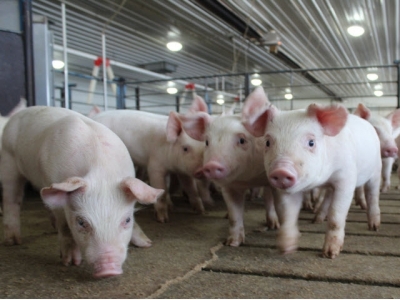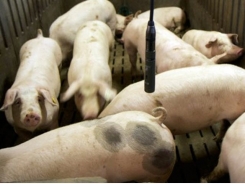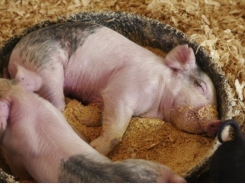How to formulate energy-rich diets for growing piglets

Energy is the most expensive, critical and essential nutrient in any pig feed, and a nutrient that is used to prorate all other nutrients because pigs will consume feed first to satisfy their energy needs.
Energy is the most expensive “nutrient” in a piglet diet. Although energy is a physical property and not a nutrient (that is, a chemically distinctive compound), it is often regarded as such for simplicity.
Dietary energy is provided by sugars, such as starch and lactose; lipids, which contain about 2.5 times more energy than most carbohydrates; proteins, although there is a negative balance when proteins are used for energy; and some forms of fermentable fiber, such as hemicelluloses and pectins. Energy in the body is used for maintenance to sustain basic functions and activity; growth, including reproductive activity, in terms of protein and lipid deposition; and thermogenesis, when ambient temperature falls below the thermoneutral zone.
1/ Selection of energy system
Energy requirements in pigs are described in scientific reports mostly in terms of metabolizable energy, which accounts not only for fecal (that is, digestible energy) but also for energy losses in urine. In contrast, most available trial-based data regarding energy density in feedstuffs is in terms of digestible energy. Nevertheless, the net energy system is considered as the most accurate, and it enjoys widespread approval and use nowadays. The net energy system has been validated extensively in growing-finishing pigs, and it appears that it is also valid for young pigs and breeding animals.
Because fast-growing pigs require fewer days to reach a specific body weight target, fast growth is very efficient in early life.
According to international standards, the correct unit for measuring energy is the joule (J). Nevertheless, the calorie (cal) is still very popular in nutrition textbooks and, thus, dietary energy concentrations are often expressed in both megajoules (MJ) and kilocalories (Kcal). Conversions from MJ to Kcal may be easily obtained by multiplying MJ by 239.
2/ Energy in feedstuffs
The average energy content of most common ingredients and practical diets used in commercial conditions can be estimated from their chemical composition (Equations 1, 2, 3 and 4 below; results are in MJ/kg). This is particularly useful in evaluating new varieties or sources of ingredients that deviate somewhat in chemical composition from reference materials.
- Equation 1 (NRC, 1998)
GE = [4,143 + (56 x % EE) + (15 x %CP) – (44 x %Ash)] / 239, r2 = 0.98
- Equation 2 (Noblet and Perez, 1993)
DE = [4,151 + (38 x %EE) + (23 x %CP) – (122 x %Ash) – (64 x %CF)] / 239, r2 = 0.90
- Equation 3 (Noblet and Perez, 1993)
ME = DE x (1.003 – [0.0021 x %CP])
- Equation 4 (Noblet et al., 1994)
NE = [(0.703 x DE) + (15.8 x %EE) + (4.7 x %Starch) – (9.7 x %CP) – (9.8 x %CF)] / 239, r2 = 0.97
For most practical, complete diets, metabolizable energy can be assumed to be roughly 96 percent of digestible energy. A more accurate estimate, however, would take into account dietary protein content, which, in excess of requirements, requires energy for catabolism and excretion in urine as urea. Therefore, low-protein diets, well-balanced for all amino acids, contain more metabolizable energy than diets with higher protein and same digestible energy concentrations, at least theoretically. Similarly, the net energy concentration in most ingredients and practical diets is about 71 percent of digestible energy, or 74 percent of metabolizable energy.
3/ Energy for growth
Energy requirements for maintenance and moderate activity are expressed on a metabolic body weight basis (BW0.75) because this accounts for changes in the relationship between weight and body surface, which increases as pigs grow.
The daily metabolizable energy requirement for maintenance (MEm) is 0.44 MJ ME x kg BW0.75. This is equivalent to about 0.46 MJ DE/kg BW0.75 or 0.36 MJ NE/kg BW0.75. Energy used for maintenance does not produce, obviously, any profit-yielding product and it is, thus, considered an undesirable, yet unavoidable, expense. The relative contribution of maintenance to total energy requirements increases as pigs grow heavier and decreases as pigs grow faster. For example, a 5-kg pig requires daily 1.5 MJ ME for maintenance and about 4 MJ ME for 250 g of growth. In this scenario, the MEm is about 27 percent of total energy requirements, but had growth rate been double, MEm would have been only 16 percent of the total. In contrast, a 30-kg pig requires 5.6 MJ ME for maintenance and 6.4 MJ ME to grow at 400 g per day. In this heavier pig, the MEm is almost half of total energy needs (47 percent), but with a double growth rate, this figure falls to 30 percent. Because fast-growing pigs require less days to reach a specific body weight target, fast growth is very efficient in early life as maintenance requirements are minimized.
For growth, pigs require about 44 MJ ME per kg deposited protein and approximately 55 MJ per kg deposited lipid. Assuming that 1 kg lean tissue contains about 20 percent protein, it is evident that depositing 1 kg of fat is energetically more expensive than 1 kg of lean tissue. Thus, efficiency of feed utilization is always improved when pigs deposit more lean than fat tissue. This is another reason why growth in early life, which is primarily lean gain, is so desirable and profitable. Young pigs require about 16 MJ ME/kg body weight gain, assuming 1:1 protein to lipid ratio in weight gain.
4/ Dietary energy density
In general, pigs given diets with different energy density try to maintain similar energy intake by adjusting feed intake. Of course, when diets are too dilute that pigs reach their physical gut capacity before they meet their energy needs, or too dense that pigs cannot satiate hunger, then constant energy intake cannot be achieved. However, the ability of pigs to compensate for decreasing dietary energy concentration is related to pig size.
Pigs of high genetic merit growing below their potential for lean gain (as a result of limited, voluntary feed intake) are not able to adjust their energy intake when presented with low energy diets. It appears that, in general, modern pigs of less than 50 kg in body weight cannot regulate efficiently energy intake. In this light, it has been suggested that dietary energy densities below 15.5 MJ ME/kg may reduce energy intake in pigs less than 15 kg body weight. A minimum of 14 MJ ME/kg is also suggested for pigs over 15 kg, as each MJ ME below this threshold is most likely to reduce daily energy intake by at least 1.5 MJ.
5/ Nutrient to energy ratios
When pigs become able to regulate their energy intake, it is advisable to provide all other nutrients in a constant proportion to energy to ensure similar intake at variable dietary energy densities. Because weaned piglets are expected to consume only a small amount of feed regardless of dietary energy density, it is only logical to assume that growth should be accelerated by high-energy diets. In this case, the concentration of other nutrients, and specifically of amino acids, must be proportionately increased to support growth.
It follows that the concentration of all amino acids must be in proportion to lysine according to the ideal protein concept. There is no scientific evidence to indicate that mineral and vitamin concentrations should not be similarly adjusted to reflect energy density, although this is not practiced often, perhaps because these nutrients are always supplied in excesses. Finally, it should be noted that certain additives and medications are not adjusted to reflect energy density, as their concentration is often regulated by law.
Related news
Tools

Phối trộn thức ăn chăn nuôi

Pha dung dịch thủy canh

Định mức cho tôm ăn

Phối trộn phân bón NPK

Xác định tỷ lệ tôm sống

Chuyển đổi đơn vị phân bón

Xác định công suất sục khí

Chuyển đổi đơn vị tôm

Tính diện tích nhà kính

Tính thể tích ao




 Three ways to implement piglet creep feeding
Three ways to implement piglet creep feeding  Three ways piglet diets can benefit from wheat…
Three ways piglet diets can benefit from wheat…